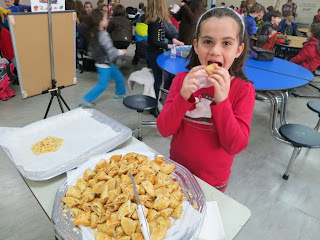One of the exciting moments for me was talking to Bill Yosses, the executive pastry chef at the White House. I had met him before when I went on the White House Fall Social Garden Tour in October last year. At TEDx he spoke about cooking with kids and integrating science curriculum into cooking classes. At the break I got a chance to speak with him. I handed him a recipe card I made from one of our Chef in the Classroom visits last year. The recipe was for Super Delicious, Extra Nutritious Carrot Brownies from Mrs. Quick's 2nd grade class. He looked at it and said, "Carrot Brownies...looks like an interesting recipe, I'll have to try and make it."
Well folks, the Obamas may be eating one of Haldane's Chef in the Classroom recipes!
If you are interested in hearing any of the speakers from TEDx Manhattan 2013, they will be available online shortly. In the meantime, I highlighted a few of the speakers I found most thought-provoking.
The event opened with LaDonna Redmond the Senior Program Associate in Food and Justice at the Institute for Agriculture and Trade Policy. She is a long-time community activist who has successfully worked to get Chicago Public Schools to evaluate junk food, launched urban agriculture projects, started a community grocery store, and worked on federal farm policy to expand access to healthy food in low-income communities. "There has never been a fair, just, healthy food system in America," she said. "It is easier to buy a semi-automatic weapon in the South Side of Chicago than a tomato."
Simran Sethi has been named one of the top ten "eco-heroes" of the planet by the UK's Independent and lauded as the "environmental messenger" by Vanity Fair. Simran Sethi is an award-winning journalist, strategist and educator. She talked about seeds. I'll highlight some of her talking points:
- Seeds are sex. Sex is the act that causes life to begin so seeds are in essence sex packets. Seeds are the building blocks of every meal we eat: fruits, vegetables, grains, and the meats that are raised on grasses and grains. But more than just food, they are cotton for clothes, corn for fuel, wood for shelter, and plants for medicine. Yet half of the calories consumed in the U.S. come from just four crops: rice, wheat, potatoes, and corn. There are 80,000 types of seeds, 850 are farmed for crops. But only 30 species make up 95% of our caloric intake. Since 1900, 75% of all crop varieties have disappeared. As stated by Wendell Berry, eating is an agricultural act. We must eat food to save it.
Peter Lehner the Executive Director of NRDC spoke about food waste in America. Forty percent of food grown in this country isn't eaten. One-fifth of what goes into a landfill is food. Six billion pounds of food are wasted on farms per year. The average American family throws out 25 pounds of food per month. Yet, nearly 50 million Americans today (one in four children) don't know where there next meal is coming from.
Cheryl Kollin talked about her project: Farm to Freezer - a partnership with Bethesda Cares that addresses surplus fresh produce, hunger, and food waste. This social enterprise preserves donated fresh, local food at its peak ripeness; provides healthier food for Bethesda Cares' homeless client meals; supports local farmers; reduces food waste; provides community service opportunities; and raises local awareness about homelessness, nutrition, and locally-grown food.
Ann Cooper, a graduate of the Culinary Institute of America, often referred to as the "Renegade Lunch Lady" gave a rousing talk about changing school food and the growing farm to school movement.
All in all, it was a great day with great people, great food, great conversations, and great motivation to keep on plugging along, working for positive change.
Cheers!




















